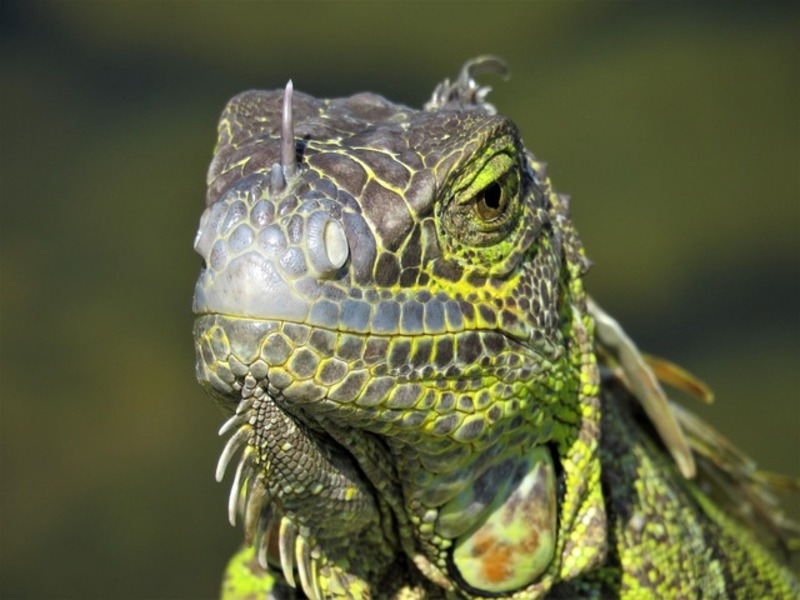
Iguana as Pets
Published on June 26, 2025
Green iguanas, with their striking appearance and calm demeanor when properly socialized, can be incredibly captivating pets. However, they are often purchased without a full understanding of their complex needs, leading to health issues and rehoming. These large, arboreal lizards require a significant commitment in terms of space, diet, and environmental control. With proper care, an iguana can live for 15-20 years, sometimes even longer, becoming a truly impressive and interactive companion.
This comprehensive guide will outline the essential aspects of iguana care, helping prospective owners understand the dedication required to provide a thriving environment for these magnificent reptiles.
Are Iguanas the Right Pet for You?
Iguanas are not beginner reptiles. Their needs are demanding, and their size requires considerable space. They are best suited for owners who are prepared for:
- Large Size: Adult green iguanas can reach 5-6 feet in length, including their tail.
- Long Lifespan: A commitment of 15-20 years or more.
- Extensive Housing: They need very large, tall, custom-built enclosures.
- Precise Environmental Control: Strict requirements for temperature, humidity, and UVB lighting.
- Herbivorous Diet: A specific and varied diet of leafy greens and vegetables.
- Potential for Aggression: While they can be tamed, males, especially during breeding season, can become territorial and aggressive if not properly handled and socialized.
1. Enclosure: Go Big or Go Home
The enclosure is the single most critical investment for an iguana. A juvenile can start in a 40-gallon breeder tank, but they grow rapidly. An adult iguana requires an enclosure that is at least 6 feet tall, 4 feet wide, and 3 feet deep. Custom-built enclosures are often necessary.
- Vertical Space: As arboreal creatures, they need height for climbing and basking.
- Substrate: Newspaper, paper towels, or reptile carpet are safe and easy to clean. Avoid substrates that can be ingested and cause impaction (e.g., sand, wood chips).
- Branches & Perches: Provide sturdy, non-toxic branches for climbing and basking. Ensure they can support the iguana's weight.
- Hides: Offer multiple secure hiding spots where your iguana can feel safe and sleep.
2. Heating and Lighting: Mimicking the Tropics
Iguanas are ectothermic (cold-blooded) and require precise temperature gradients and full-spectrum lighting.
- Basking Spot: A basking surface temperature of 90-95°F (32-35°C) is crucial for digestion and metabolism. Use a high-wattage basking bulb.
- Ambient Temperature: A cool side of 75-80°F (24-27°C) and a warm side of 85-90°F (29-32°C). Nighttime temperatures should not drop below 70-75°F (21-24°C).
- UVB Lighting: A high-output linear UVB bulb (e.g., T5 HO 10.0 or 12.0) spanning 2/3 to 3/4 of the enclosure is absolutely essential for calcium metabolism and preventing Metabolic Bone Disease (MBD). It should be on for 10-12 hours a day.
- Humidity: Maintain 70-80% humidity. This can be achieved through misting (2-3 times daily), a large water bowl, and a fogger/mister.
3. Diet: Strictly Herbivorous
Iguanas are herbivores, and their diet should consist primarily of leafy greens and vegetables. A common mistake is feeding too much fruit or animal protein, which can lead to severe health issues.
- Staple Greens (80-90%): Collard greens, mustard greens, turnip greens, dandelion greens, hibiscus leaves, escarole, endive.
- Other Vegetables (10-20%): Squash, bell peppers, green beans, carrots.
- Fruits (Very Sparingly, as treats): Berries, melon, apple.
- Supplements: Dust food with a calcium supplement (without D3, as UVB provides D3) daily for juveniles and 3-4 times a week for adults. A multivitamin should be used 1-2 times a week.
4. Hydration and Bathing
Provide a large, sturdy water bowl that your iguana can easily climb into and out of. Daily misting is important for hydration. Regular warm baths (20-30 minutes, 2-3 times a week) help with hydration, shedding, and cleanliness.
5. Handling and Socialization
Iguanas can become very tame with consistent, gentle, and frequent handling from a young age. Regular interaction builds trust. However, they can be powerful and may use their tails to whip or bite if they feel threatened. Proper handling techniques and understanding their body language are essential.
6. Veterinary Care
Find a veterinarian experienced with exotic reptiles before you acquire an iguana. Regular check-ups are essential, and they can advise on proper diet, supplements, and any health concerns, especially MBD.
Conclusion
Iguanas are magnificent and intelligent creatures that can make rewarding pets for dedicated owners. However, their significant size, long lifespan, and precise environmental and dietary needs mean they are a serious, long-term commitment. Ensure you are fully prepared to provide the extensive care required before bringing one of these impressive reptiles into your home.